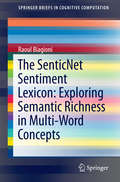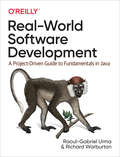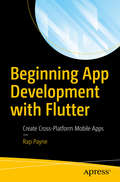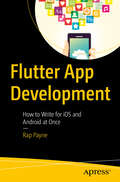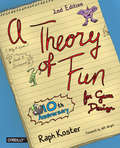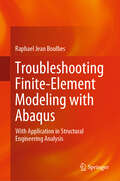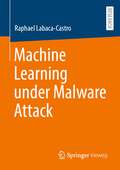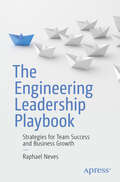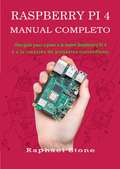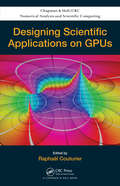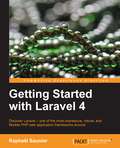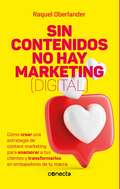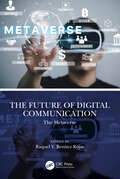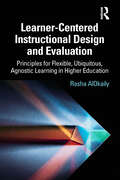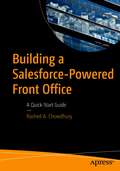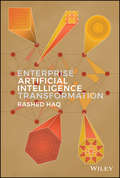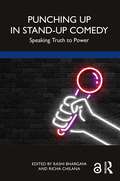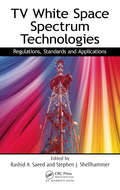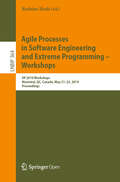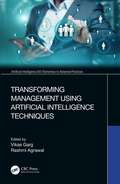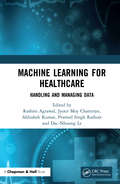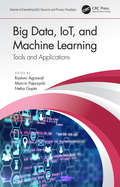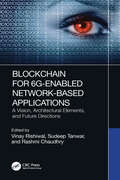- Table View
- List View
The SenticNet Sentiment Lexicon: Exploring Semantic Richness in Multi-Word Concepts
by Raoul BiagioniThe research and its outcomes presented in this book, is about lexicon-based sentiment analysis. It uses single-, and multi-word concepts from the SenticNet sentiment lexicon as the source of sentiment information for the purpose of sentiment classification. In 6 chapters the book sheds light on the comparison of sentiment classification accuracy between single-word and multi-word concepts, for which a bespoke sentiment analysis system developed by the author was used. This book will be of interest to students, educators and researchers in the field of Sentic Computing.
Real-World Software Development: A Project-Driven Guide to Fundamentals in Java
by Richard Warburton Raoul-Gabriel UrmaExplore the latest Java-based software development techniques and methodologies through the project-based approach in this practical guide. Unlike books that use abstract examples and lots of theory, Real-World Software Development shows you how to develop several relevant projects while learning best practices along the way.With this engaging approach, junior developers capable of writing basic Java code will learn about state-of-the-art software development practices for building modern, robust and maintainable Java software. You’ll work with many different software development topics that are often excluded from software develop how-to references.Featuring real-world examples, this book teaches you techniques and methodologies for functional programming, automated testing, security, architecture, and distributed systems.
Beginning App Development with Flutter: Create Cross-Platform Mobile Apps
by Rap PayneCreate iOS and Android apps with Flutter using just one codebase. App development on multiple platforms has historically been difficult and complex. This book breaks down complex concepts and tasks into easily digestible segments with examples, pictures, and hands-on labs with starters and solutions. In doing so, you'll develop a basic understanding of the Dart programming language; the entire Flutter development toolchain; the differences between stateful and stateless widgets; and a working knowledge of the architecture of apps. All the most important parts of app development with Flutter are covered in this book. Work with themes and styles. Develop custom widgets. Teach your app to respond to gestures like taps, swipes, and pinches. Design, create and control the layout of your app. Create tools to handle form data entry from users. And ultimately create killer multiscreen apps with navigation, menus, and tabs.Flutter is Google's new framework for creating mobile apps that run on iOS and Android phones both.You had to be a super-developer to write apps for iOS or Android alone. But writing for both? Forget about it! You had to be familiar with Swift, Java/Kotlin, Xcode, Eclipse, and a bunch of other technologies simultaneously. Beginning App Development with Flutter simplifies the entire process.What You'll Learn Get the most out of great Flutter widgets Create custom widgets, both stateless and statefulExercise expert control over your Flutter layoutsMake your app respond to gestures like swiping, pinching and tappingInitiate async Ajax calls to RESTful APIs — including Google Firebase!Who This Book Is ForDevelopers who have coded in Java, C#, C++, or any similar language. It brings app development within the reach of younger developers, so STEM groups are likely to pick up the technology. Managers, product owners, and business analysts need to understand Flutter's capabilities.
Flutter App Development: How to Write for iOS and Android at Once
by Rap PayneCreate apps for iOS and Android phones and tablets using Flutter, a Google framework that produces two outputs for a single app. Let's face it, creating iOS apps using Apple tools such as Swift and Xcode is extremely complicated. Creating Android apps with Kotlin and Android Studio is just as difficult. This book breaks down complex concepts and tasks into easily digestible segments with examples, full-color pictures, and hands-on labs with starters and solutions. As you work through the accompanying lab exercises, you'll learn the Dart programming language; the entire Flutter development toolchain; the differences between stateful and stateless widgets; and a working knowledge of the architecture of apps. You’ll work with themes and styles, develop custom widgets, and even teach your app to respond to gestures like taps, swipes, and pinches. You’ll also design, create, and control the layout of your app. Create tools to handle form data entry from users. And ultimately create killer multiscreen apps with navigation, menus, and tabs. You’ll see that with Flutter, you can write an app one time that produces two outputs: one that can be submitted to the Apple App Store and another that can be uploaded to the Google Play Store. In short, one code creates the same app that runs on iPhones, iPads, Android phones and tablets, virtually all devices. And if you like, it can also create a version that runs on Macs, Windows, Linux, and in browsers! Flutter App Development explains difficult topics in plain, everyday terms that simplify the process of writing mobile apps. What You'll Learn Get the most out of great Flutter widgets Create custom widgets, both stateless and stateful Exercise expert control over your Flutter layouts Manage data in stateful widgets and with libraries like Riverpod Exchange data actively with RESTful API servers Who This Book Is For Developers who have coded in JavaScript, Python, Java, C#, C++, or any similar language. Managers, product owners, and business analysts who need to understand Flutter's capabilities.
Theory of Fun for Game Design
by Raph KosterNow in full color, the 10th anniversary edition of this classic book takes you deep into the influences that underlie modern video games, and examines the elements they share with traditional games such as checkers. At the heart of his exploration, veteran game designer Raph Koster takes a close look at the concept of fun and why it’s the most vital element in any game.Why do some games become boring quickly, while others remain fun for years? How do games serve as fundamental and powerful learning tools? Whether you’re a game developer, dedicated gamer, or curious observer, this illustrated, fully updated edition helps you understand what drives this major cultural force, and inspires you to take it further.You’ll discover that:Games play into our innate ability to seek patterns and solve puzzlesMost successful games are built upon the same elementsSlightly more females than males now play gamesMany games still teach primitive survival skillsFictional dressing for modern games is more developed than the conceptual elementsTruly creative designers seldom use other games for inspirationGames are beginning to evolve beyond their prehistoric origins
Confronting the Internet’s Dark Side
by Raphael Cohen-AlmagorTerrorism, cyberbullying, child pornography, hate speech, cybercrime: along with unprecedented advancements in productivity and engagement, the Internet has ushered in a space for violent, hateful, and antisocial behavior. How do we, as individuals and as a society, protect against dangerous expressions online? Confronting the Internet's Dark Side is the first book on social responsibility on the Internet. It aims to strike a balance between the free speech principle and the responsibilities of the individual, corporation, state, and the international community. This book brings a global perspective to the analysis of some of the most troubling uses of the Internet. It urges net users, ISPs, and liberal democracies to weigh freedom and security, finding the golden mean between unlimited license and moral responsibility. This judgment is necessary to uphold the very liberal democratic values that gave rise to the Internet and that are threatened by an unbridled use of technology.
Troubleshooting Finite-Element Modeling with Abaqus: With Application in Structural Engineering Analysis
by Raphael Jean BoulbesThis book gives Abaqus users who make use of finite-element models in academic or practitioner-based research the in-depth program knowledge that allows them to debug a structural analysis model. The book provides many methods and guidelines for different analysis types and modes, that will help readers to solve problems that can arise with Abaqus if a structural model fails to converge to a solution. The use of Abaqus affords a general checklist approach to debugging analysis models, which can also be applied to structural analysis.The author uses step-by-step methods and detailed explanations of special features in order to identify the solutions to a variety of problems with finite-element models. The book promotes: • a diagnostic mode of thinking concerning error messages; • better material definition and the writing of user material subroutines; • work with the Abaqus mesher and best practice in doing so; • the writing of user element subroutines and contact features with convergence issues; and• consideration of hardware and software issues and a Windows HPC cluster solution.The methods and information provided facilitate job diagnostics and help to obtain converged solutions for finite-element models regarding structural component assemblies in static or dynamic analysis. The troubleshooting advice ensures that these solutions are both high-quality and cost-effective according to practical experience. The book offers an in-depth guide for students learning about Abaqus, as each problem and solution are complemented by examples and straightforward explanations. It is also useful for academics and structural engineers wishing to debug Abaqus models on the basis of error and warning messages that arise during finite-element modelling processing.
Machine Learning under Malware Attack
by Raphael Labaca CastroMachine learning has become key in supporting decision-making processes across a wide array of applications, ranging from autonomous vehicles to malware detection. However, while highly accurate, these algorithms have been shown to exhibit vulnerabilities, in which they could be deceived to return preferred predictions. Therefore, carefully crafted adversarial objects may impact the trust of machine learning systems compromising the reliability of their predictions, irrespective of the field in which they are deployed. The goal of this book is to improve the understanding of adversarial attacks, particularly in the malware context, and leverage the knowledge to explore defenses against adaptive adversaries. Furthermore, to study systemic weaknesses that can improve the resilience of machine learning models.
The Engineering Leadership Playbook: Strategies for Team Success and Business Growth
by Raphael NevesIn today's business landscape, software engineering teams must deliver innovation faster than ever. However, outdated management approaches centered on tools and metrics rather than people strangle velocity and creativity. Legacy leaders cling to rigid structures mismatched with market dynamics, draining effort and morale from burnt-out teams. The Engineering Leadership Playbook provides a modern framework to unlock your team's potential through empathy, clarity, and empowerment. Unlike traditional leadership books fixated on delivery metrics, Raphael Neves offers a refreshing people-oriented leadership model tailored to nuances of engineering culture. With 15+ years leading high-growth tech teams, Raphael demystifies how to balance autonomy with alignment, reconstruct feedback models on psychological safety, and sustain excellence amidst uncertainty. You'll learn his proven conflict resolution blueprint for defusing clashes through mutual understanding while tangibly tracking progress. Additionally, his continuous feedback system grounded in evidence spotlights gaps early while accelerating strengths. This playbook moves systematically from foundational concepts like emotional intelligence and leading by example into team development frameworks around high-impact coaching, mentorship, and performance reviews. The method is brought full circle through innovation catalysts that maintain creative momentum at scale. Step-by-step, Raphael unpacks human-centered leadership aligned with accelerating market realities. Apply his engineering management playbook, and your teams will thrive fueled by vision, trust, and care. What You'll Learn Study different leadership styles and how to switch their approaches depending on circumstances Review critical communication skills, especially in technical fields Create IDPs for team members, especially senior engineers and leaders Who This Book Is For Current engineering leaders, aspiring engineering leaders, senior engineers, HR professionals and recruiters, and professionals in related fields
Raspberry Pi 4 Manual Completo: Una guía paso a paso a la nueva Raspberry Pi 4 y a la creación de proyectos innovadores.
by Raphael StoneFelicitaciones por convertirte en un explorador de la Raspberry Pi 4. Estamos seguros de que disfrutarás descubrir un mundo de la informática completamente nuevo y la posibilidad de crear tus propios juegos, controlar tus propios robots y máquinas, y compartir tus experiencias con otros fanáticos de la Raspberry Pi. La Raspberry Pi 4 puede hacer una cantidad sorprendente de cosas. Los entusiastas de la tecnología aficionados utilizan las placas Pi como centros de medios, servidores de archivos, consolas de juegos retro, enrutadores y bloqueadores de anuncios a nivel de red, sólo por mencionar algunos. Sin embargo, eso es solo una muestra de lo que es posible. Hay cientos de proyectos por ahí, donde la gente ha utilizado a la Pi para construir tabletas, computadoras portátiles, teléfonos, robots, espejos inteligentes, tomar fotografías en el espacio exterior, o para realizar experimentos en la Estación Espacial Internacional. Con la Pi 4 siendo más rápida, capaz de decodificar video 4K, beneficiándose de un almacenamiento más rápido a través de USB 3.0 y conexiones de red más rápidas a través de Ethernet de un Gigabit, la puerta está abierta a muchos usos nuevos. También es la primer Pi que admite dos pantallas, hasta dos pantallas 4K@30, una bendición para los creativos que desean más espacio en el escritorio. No tienes que ser un científico espacial para comenzar a desarrollar tus propios proyectos; El MANUAL COMPLETO DE RASPBERRY PI 4 está aquí para revolucionar la forma en que percibes la informática de una vez por todas. Aquí hay un resumen de lo que aprenderás: • Configuración de tu Raspberry Pi 4 • Cómo instalar software • Instalación de Windows 10 en Raspberry Pi 4 • Comandos Raspberry Pi • Cómo construir robots • Cómo hacer juegos • Instalación de paquetes • Crear y ejecutar un script de Shell �
Designing Scientific Applications on GPUs (Chapman & Hall/CRC Numerical Analysis and Scientific Computing Series)
by Raphaël CouturierMany of today's complex scientific applications now require a vast amount of computational power. General purpose graphics processing units (GPGPUs) enable researchers in a variety of fields to benefit from the computational power of all the cores available inside graphics cards.Understand the Benefits of Using GPUs for Many Scientific Applications
Getting Started with Laravel 4
by Raphaël SaunierThis book follows a practical and easy-to-follow approach and is packed with real-world examples to understand all the fundamentals and concepts in a very concise way. This book is ideal for web developers who want to get up to speed with Laravel quickly. You are expected to have some experience with the PHP programming language - or any C-like languages such as JavaScript, Perl, or Java - along with some understanding of basic OOP concepts. Any experience with MVC frameworks such as ASP.NET MVC or Ruby on Rails will certainly be beneficial but not required. Lastly, some familiarity with command line interfaces will also help but is not essential either.
Sin contenidos no hay marketing (digital)
by Raquel OberlanderCómo crear una estrategia de content marketing para enamorar a tus clientes y transformarlos en embajadores de tu marca. El mundo cambió. Los seres humanos cambiamos. El marketing también debe hacerlo. Y para eso solo hay un camino: los contenidos, que permiten entregar valor real a las personas. Hacer marketing de contenidos es mucho más que levantarse un día y subir un post a Instagram o un video a TikTok. Es definir una estrategia, trazar un plan y ejecutarlo. Un proceso que implica muchísimas etapas, tareas, canales, tácticas, roles y saberes, que Raquel Oberlander tuvo la capacidad de condensar en un modelo al que bautizó HEPIC 10 y que comparte con infinita generosidad en este libro. Crear contenidos obliga a las organizaciones a definir un propósito que va mucho más allá de las ventas y la rentabilidad. Obliga a mirar el alma, en lugar de mirarse el ombligo. Y luego entregar aquello que se descubre en forma de mensajes que no interrumpan lo que las personas están viendo, sino que sean lo que quieren ver (o leer o escuchar). Sin contenidos no hay marketing (digital) está dedicado a profesionales de marketing y comunicación, pero también a los CEO, gerentes, emprendedores, músicos, abogados, contadores, coaches, porque, de una manera u otra, todos necesitamos generar contenido para promover el crecimiento de nuestros proyectos y de nuestra marca personal. Y también es ideal para los creadores de contenido, ya sean productores audiovisuales, diseñadores gráficos, redactores, influencers, freelancers, community managers, que son los aliados clave y grandes protagonistas en este proceso.
The Future of Digital Communication: The Metaverse
by Raquel V. Benítez RojasThis collection of essays explores the present and future of digital communication through a range of interdisciplinary approaches, all of which focus on the so-called metaverse. The metaverse is a combination of multiple elements of technology – including virtual reality, augmented reality, and video – where users "live" within a digital universe. The vision for this new universe is that its users can work, play, and stay connected with friends through everything. Such a vision is hinted at in existing phenomena such as online game universes.
Learner-Centered Instructional Design and Evaluation: Principles for Flexible, Ubiquitous, Agnostic Learning in Higher Education
by Rasha AlOkailyLearner-Centered Instructional Design and Evaluation offers a forward-thinking, evidence-based vision of technology-enhanced higher education that taps into today’s digital access opportunities for more dynamic, agnostic, and inclusive learning experiences. The recent ubiquity of digital devices has fostered a new generation of learners who are technologically adept, engage in rapid social co-construction of knowledge, and expect increased choice and personalisation of educational content and environment. Colleges and universities, however, continue to apply their technology tools into outdated, passive pedagogies. Based on theory and empirical research, this book’s innovative framework guides scholars and practitioners toward instructional design and evaluation approaches that leverage the anytime-anywhere potential of wireless networked devices to foster flexible learning experiences and device-neutral assignments. Each chapter is rich with designs, deliveries, and evaluations of lesson plans, projects, and other real-world course works exemplifying the procedures and principles that will rejuvenate learning amid the globalisation, commodification, and massification of higher education.
Building a Salesforce-Powered Front Office: A Quick-Start Guide
by Rashed A. ChowdhuryHarness the power of Salesforce to manage and grow your business. This book shows you how to use the Salesforce CRM tool to consolidate consumer data into a single place to gain better insight into your business and more easily manage data.Data (such as email, spreadsheets, databases) is generated through the front office or face of your business, where your company interacts with customers and revenue is generated. In a hotel, for instance, the front office is the lobby where guests are greeted, their problems are handled, and room payments are made. Another example is a coffee shop, where the front office is an employee taking a customer's order or serving a drink.Salespeople connect to customers by selling your company’s goods or services. Marketing team members connect with them through advertising and promotional activities. Service and support staff assist customers with problems and provide help with products.This book introduces the many ways Salesforce-based innovations are transforming the technology landscape and the strategies that may be used for designing and launching a digital front office. The book examines how organizations can launch and grow digital solutions and strategies for the governance of the platform and provides an overview of digital transformation across industries. What You Will Learn Understand basic Salesforce concepts, including the digital front office process tower, lead to cash journey, core CRM functions, best practices, and moreReview data management concepts, integrated sales, customer service, marketing operations, and proposal and business development needs in a systematic wayUse frameworks to build a business architecture and multi-year technology roadmapGet familiar with Salesforce business processes and concepts such as account, contact, lead, and opportunity management; marketing campaigns; master data management (MDM); and lead scoring, grading, and activity management across the front officeDefine and develop digital marketing challenges and strategy (people, process, brand, messaging, and ROI), measure campaign data, and create an end-to-end campaign in Salesforce Who This Book Is ForBusiness executives, C-suites, IT management, and Salesforce managers and professionals working in IT, business development, sales operations, program management, marketing operations, and proposal development
Enterprise Artificial Intelligence Transformation
by Rashed HaqEnterprise Artificial Intelligence Transformation AI is everywhere. From doctor's offices to cars and even refrigerators, AI technology is quickly infiltrating our daily lives. AI has the ability to transform simple tasks into technological feats at a human level. This will change the world, plain and simple. That's why AI mastery is such a sought-after skill for tech professionals. Author Rashed Haq is a subject matter expert on AI, having developed AI and data science strategies, platforms, and applications for Publicis Sapient's clients for over 10 years. He shares that expertise in the new book, Enterprise Artificial Intelligence Transformation. The first of its kind, this book grants technology leaders the insight to create and scale their AI capabilities and bring their companies into the new generation of technology. As AI continues to grow into a necessary feature for many businesses, more and more leaders are interested in harnessing the technology within their own organizations. In this new book, leaders will learn to master AI fundamentals, grow their career opportunities, and gain confidence in machine learning. Enterprise Artificial Intelligence Transformation covers a wide range of topics, including: Real-world AI use cases and examples Machine learning, deep learning, and slimantic modeling Risk management of AI models AI strategies for development and expansion AI Center of Excellence creating and management If you're an industry, business, or technology professional that wants to attain the skills needed to grow your machine learning capabilities and effectively scale the work you're already doing, you'll find what you need in Enterprise Artificial Intelligence Transformation.
Punching Up in Stand-Up Comedy: Speaking Truth to Power
by Rashi Bhargava Richa ChilanaPunching Up in Stand-Up Comedy explores the new forms, voices and venues of stand-up comedy in different parts of the world and its potential role as a counterhegemonic tool for satire, commentary and expression of identity especially for the disempowered or marginalised. The title brings together essays and perspectives on stand-up and satire from different cultural and political contexts across the world which raise pertinent issues regarding its role in contemporary times, especially with the increased presence of OTT platforms and internet penetration that allows for easy access to this art form. It examines the theoretical understanding of the different aspects of the humour, aesthetics and politics of stand-up comedy, as well as the exploration of race, gender, politics and conflicts, urban culture and LGBTQ+ identities in countries such as Indonesia, Finland, France, Iran, Italy, Morocco, India and the USA. It also asks the question whether, along with contesting and destabilising existing discursive frameworks and identities, a stand-up comic can open up a space for envisaging a new social, cultural and political order? This book will appeal to people interested in performance studies, media, popular culture, digital culture, sociology, digital sociology and anthropology, and English literature.
TV White Space Spectrum Technologies: Regulations, Standards, and Applications
by Rashid A. Saeed Stephen J. ShellhammerAlthough sophisticated wireless radio technologies make it possible for unlicensed wireless devices to take advantage of un-used broadcast TV spectra, those looking to advance the field have lacked a book that covers cognitive radio in TV white spaces (TVWS). Filling this need, TV White Space Spectrum Technologies: Regulations, Standards and Applic
Learning IoT with Particle Core and Photon
by Rashid KhanThis book is for developers, IoT enthusiasts, and hobbyists who want to enhance their knowledge of IoT machine-to-machine architecture using Particle Photon and Electron, and implement cloud-based IoT projects.
Agile Processes in Software Engineering and Extreme Programming – Workshops: XP 2019 Workshops, Montréal, QC, Canada, May 21–25, 2019, Proceedings (Lecture Notes in Business Information Processing #364)
by Rashina HodaThis open access book constitutes the research workshops, doctoral symposium and panel summaries presented at the 20th International Conference on Agile Software Development, XP 2019, held in Montreal, QC, Canada, in May 2019.XP is the premier agile software development conference combining research and practice. It is a hybrid forum where agile researchers, academics, practitioners, thought leaders, coaches, and trainers get together to present and discuss their most recent innovations, research results, experiences, concerns, challenges, and trends. Following this history, for both researchers and seasoned practitioners XP 2019 provided an informal environment to network, share, and discover trends in Agile for the next 20 years. Research papers and talks submissions were invited for the three XP 2019 research workshops, namely, agile transformation, autonomous teams, and large scale agile. This book includes 15 related papers. In addition, a summary for each of the four panels at XP 2019 is included. The panels were on security and privacy; the impact of the agile manifesto on culture, education, and software practices; business agility – agile’s next frontier; and Agile – the next 20 years.
Transforming Management Using Artificial Intelligence Techniques (Artificial Intelligence (AI): Elementary to Advanced Practices)
by Vikas Garg Rashmi AgrawalTransforming Management Using Artificial Intelligence Techniques redefines management practices using artificial intelligence (AI) by providing a new approach. It offers a detailed, well-illustrated treatment of each topic with examples and case studies, and brings the exciting field to life by presenting a substantial and robust introduction to AI in a clear and concise manner. It provides a deeper understanding of how the relevant aspects of AI impact each other’s efficacy for better output. It’s a reliable and accessible one-step resource that introduces AI; presents a full examination of applications; provides an understanding of the foundations; examines education powered by AI, entertainment, home and service robots, healthcare re-imagined, predictive policing, space exploration; and so much more, all within the realm of AI. This book will feature: Uncovering new and innovative features of AI and how it can help in raising economic efficiency at both micro- and macro levels Both the literature and practical aspects of AI and its uses This book summarizing key concepts at the end of each chapter to assist reader comprehension Case studies of tried and tested approaches to resolutions of typical problems Ideal for both teaching and general-knowledge purposes. This book will also simply provide the topic of AI for the readers, aspiring researchers and practitioners involved in management and computer science, so they can obtain a high-level of understanding of AI and managerial applications.
Machine Learning for Healthcare: Handling and Managing Data
by Rashmi Agrawal, Jyotir Moy Chatterjee, Abhishek Kumar, Pramod Singh Rathore and Dac-Nhuong LeMachine Learning for Healthcare: Handling and Managing Data provides in-depth information about handling and managing healthcare data through machine learning methods. This book expresses the long-standing challenges in healthcare informatics and provides rational explanations of how to deal with them. Machine Learning for Healthcare: Handling and Managing Data provides techniques on how to apply machine learning within your organization and evaluate the efficacy, suitability, and efficiency of machine learning applications. These are illustrated in a case study which examines how chronic disease is being redefined through patient-led data learning and the Internet of Things. This text offers a guided tour of machine learning algorithms, architecture design, and applications of learning in healthcare. Readers will discover the ethical implications of machine learning in healthcare and the future of machine learning in population and patient health optimization. This book can also help assist in the creation of a machine learning model, performance evaluation, and the operationalization of its outcomes within organizations. It may appeal to computer science/information technology professionals and researchers working in the area of machine learning, and is especially applicable to the healthcare sector. The features of this book include: A unique and complete focus on applications of machine learning in the healthcare sector. An examination of how data analysis can be done using healthcare data and bioinformatics. An investigation of how healthcare companies can leverage the tapestry of big data to discover new business values. An exploration of the concepts of machine learning, along with recent research developments in healthcare sectors.
Big Data, IoT, and Machine Learning: Tools and Applications (Internet of Everything (IoE))
by Rashmi Agrawal, Marcin Paprzycki, Neha GuptaThe idea behind this book is to simplify the journey of aspiring readers and researchers to understand Big Data, IoT and Machine Learning. It also includes various real-time/offline applications and case studies in the fields of engineering, computer science, information security and cloud computing using modern tools. This book consists of two sections: Section I contains the topics related to Applications of Machine Learning, and Section II addresses issues about Big Data, the Cloud and the Internet of Things. This brings all the related technologies into a single source so that undergraduate and postgraduate students, researchers, academicians and people in industry can easily understand them. Features Addresses the complete data science technologies workflow Explores basic and high-level concepts and services as a manual for those in the industry and at the same time can help beginners to understand both basic and advanced aspects of machine learning Covers data processing and security solutions in IoT and Big Data applications Offers adaptive, robust, scalable and reliable applications to develop solutions for day-to-day problems Presents security issues and data migration techniques of NoSQL databases
Blockchain for 6G-Enabled Network-Based Applications: A Vision, Architectural Elements, and Future Directions
by Sudeep Tanwar Vinay Rishiwal Rashmi ChaudhryThis book provides a comprehensive overview of blockchain for 6G-enabled network-based applications. Following the key services of blockchain technology, this book will be instrumental to ideate and understand the necessities, challenges, and various case studies of different 6G-based applications. The emphasis is on understanding the contributions of blockchain technology in 6G-enabled applications, and its aim is to give insights into evolution, research directions, challenges, and the ways to empower 6G applications through blockchain. The book consistently emphasizes the missing connection between blockchain and 6G-enabled network applications. The entire ecosystem between these two futuristic technologies is explained in a comprehensive manner. The book constitutes a one-stop guide to students, researchers, and industry professionals. The book progresses from a general introduction toward more technical aspects while remaining easy to understand throughout. Comprehensive elaboration of material is supplemented with examples and diagrams, followed by easily understandable approaches with regard to technical information given thereon. Blockchain and its applications in 6G-enabled applications can drive many powerful solutions to real-world technical, scientific, and social problems. This book presents the most recent and exciting advances in blockchain for 6G-enabled network applications. Overall, this book is a complete outlet and is designed exclusively for professionals, scientists, technologists, developers, designers, and researchers in network technologies around blockchain integration with IoT, blockchain technology, information technology, and 6G-enabled industrial applications. Secondary readers include professionals involved in policy making and administration, security of public data and law, network policy developers, blockchain technology experts, regulators, and decision makers in government administrations.
